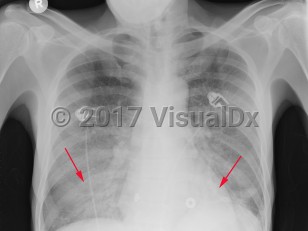Pneumocystis jirovecii pneumonia - Pulmonary
See also in: OverviewAlerts and Notices
Important News & Links
Synopsis

The distribution of the organism is worldwide, and most healthy children are exposed to it at an early age. However, disease manifestations are seen in the setting of immunosuppression. The risk of disease in the HIV-infected population rises dramatically at CD4 cell counts < 200/mm3, in the absence of appropriate prophylaxis. The presence of oral thrush and fevers are also independently associated with an increased risk, irrespective of the CD4 cell count.
Typical onset in patients with HIV is insidious with a fever and dry cough and progressive shortness of breath. Chest pain and hemoptysis may rarely be present. The symptoms may be more acute in onset in non-HIV-infected patients. Infection is often asymptomatic in lung transplant recipients.
Physical examination usually reveals fever, tachycardia, and tachypnea. The breath sounds are often normal, but in up to one third of adults, rales are present. Impaired oxygenation (arterial blood gases) is a common finding, with varying degrees of hypoxemia and elevated alveolar-arterial oxygen gradient. Although nonspecific, serum LDH is often highly elevated and declines with successful therapy.
Codes
B59 – Pneumocystosis
SNOMEDCT:
79909001 – Pneumocystis carinii
Look For
Subscription Required
Diagnostic Pearls
Subscription Required
Differential Diagnosis & Pitfalls

Subscription Required
Best Tests
Subscription Required
Management Pearls
Subscription Required
Therapy
Subscription Required
Drug Reaction Data
Subscription Required
References
Subscription Required


